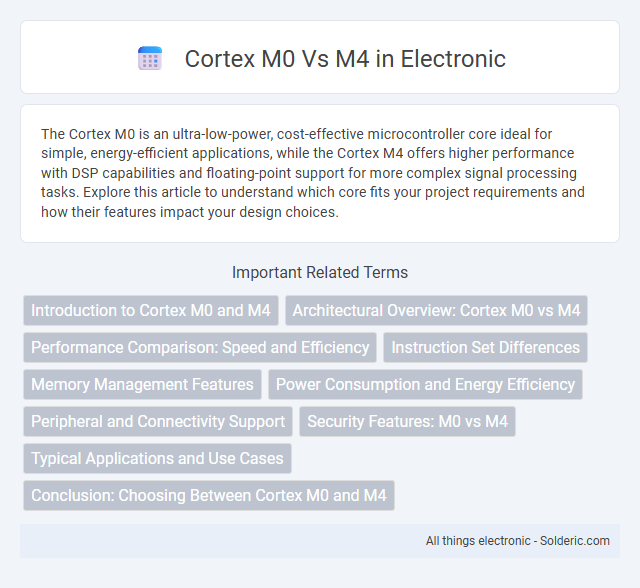The Cortex M0 is an ultra-low-power, cost-effective microcontroller core ideal for simple, energy-efficient applications, while the Cortex M4 offers higher performance with DSP capabilities and floating-point support for more complex signal processing tasks. Explore this article to understand which core fits your project requirements and how their features impact your design choices.
Comparison Table
| Feature | Cortex-M0 | Cortex-M4 |
|---|---|---|
| Processor Core | ARM Cortex-M0 | ARM Cortex-M4 |
| Architecture | 32-bit ARMv6-M | 32-bit ARMv7E-M |
| Clock Speed | Up to 50 MHz | Up to 180 MHz |
| Performance | Low power, basic processing | Higher performance, DSP instructions, FPU optional |
| Instruction Set | Thumb, Thumb-2 (subset) | Thumb, Thumb-2 with DSP extensions |
| DSP Support | No | Yes, DSP extensions included |
| Floating Point Unit (FPU) | No | Optional single-precision FPU |
| Power Consumption | Very low power | Low power, higher than M0 |
| Use Cases | Basic embedded applications, IoT sensors | Signal processing, motor control, complex embedded systems |
| Code Density | High code density | Moderate code density |
| Interrupts | Up to 32 IRQs | Up to 240 IRQs |
Introduction to Cortex M0 and M4
The Cortex-M0 is an ultra-low-power, cost-efficient 32-bit microcontroller core optimized for simple embedded applications, featuring a compact architecture ideal for energy-sensitive devices. The Cortex-M4 builds on the M0's foundation by adding digital signal processing (DSP) capabilities and optional floating-point unit (FPU), making it suitable for more complex tasks such as motor control, audio processing, and advanced sensor fusion. Your choice between Cortex-M0 and M4 depends on the balance you need between power efficiency and processing performance.
Architectural Overview: Cortex M0 vs M4
The Cortex-M0 features a simple 32-bit ARMv6-M architecture optimized for low power and cost-sensitive applications with a minimal instruction set, while the Cortex-M4 employs the more advanced ARMv7E-M architecture, integrating a hardware floating-point unit and DSP instructions for enhanced signal processing. Your choice between the two cores depends on system requirements, where the M0 excels in energy-efficient, basic embedded tasks and the M4 supports more complex applications requiring higher computational performance and real-time processing. Both architectures support the Thumb instruction set, but the M4's advanced pipeline and extended instruction set provide significant performance gains over the M0.
Performance Comparison: Speed and Efficiency
The Cortex-M4 outperforms the Cortex-M0 in speed and computational efficiency, featuring a higher clock frequency up to 168 MHz compared to the M0's typical maximum of 50 MHz. Its enhanced architecture includes a hardware multiplier and optional floating-point unit, enabling faster execution of complex algorithms and digital signal processing tasks. The Cortex-M4 balances power consumption with superior processing capabilities, making it ideal for performance-critical embedded applications.
Instruction Set Differences
The Cortex-M0 uses the ARMv6-M instruction set tailored for low power and high efficiency in simple embedded systems, while the Cortex-M4 employs the more advanced ARMv7-M instruction set, supporting DSP and single-precision floating-point instructions. The M4's extended instruction set enables enhanced signal processing capabilities, making it suitable for complex applications like audio processing and motor control. These architectural differences result in improved computational performance and real-time responsiveness in Cortex-M4 cores compared to the Cortex-M0.
Memory Management Features
The Cortex-M4 offers advanced memory management features compared to the Cortex-M0, including a Memory Protection Unit (MPU) that supports fine-grained control over memory regions, enhancing system reliability and security. The Cortex-M0 has a more basic memory system without an MPU, limiting its ability to isolate and protect memory segments. Your choice between the two depends on the need for sophisticated memory management and protection in your embedded application.
Power Consumption and Energy Efficiency
The Cortex-M0 offers ultra-low power consumption ideal for battery-operated devices, consuming significantly less energy during idle and active states compared to the Cortex-M4. The Cortex-M4, while more powerful with DSP and floating-point capabilities, requires higher energy, making it better suited for performance-critical applications where power budget is less constrained. Your choice between Cortex-M0 and Cortex-M4 should balance the need for energy efficiency with processing demands.
Peripheral and Connectivity Support
The Cortex-M4 core supports more advanced peripherals and connectivity options compared to the Cortex-M0, including DSP instructions and floating-point unit that enhance real-time signal processing capabilities. Cortex-M4 microcontrollers typically feature a wider range of communication interfaces such as CAN, USB, and advanced timers, enabling more complex and higher-speed connectivity. In contrast, Cortex-M0 devices focus on low power consumption with basic peripherals like UART, SPI, and I2C, suitable for simpler connectivity requirements.
Security Features: M0 vs M4
The Cortex-M4 offers advanced security features such as TrustZone technology, which provides hardware isolation for secure code and data, whereas the Cortex-M0 lacks this capability and only provides basic memory protection units (MPU). Your applications requiring robust security benefits from the Cortex-M4's enhanced secure boot and cryptographic acceleration support, which are absent in the M0 core. Developers prioritize the Cortex-M4 for embedded systems demanding higher levels of security and secure execution environments.
Typical Applications and Use Cases
Cortex-M0 processors excel in low-power, cost-sensitive applications such as wearable devices, IoT sensors, and simple motor control due to their minimal gate count and energy efficiency. Cortex-M4 processors, featuring DSP instructions and enhanced processing power, are ideal for audio processing, advanced motor control, digital signal processing, and real-time embedded systems requiring higher computational performance. The M4 core supports applications in automotive systems, industrial automation, and complex sensor fusion, where efficient handling of complex algorithms is essential.
Conclusion: Choosing Between Cortex M0 and M4
Cortex M0 offers a cost-effective, low-power solution ideal for simple, battery-operated applications with limited processing needs. Cortex M4 delivers higher performance with DSP capabilities and enhanced computational power, suited for complex embedded systems requiring real-time control and audio processing. Selecting between Cortex M0 and M4 depends on balancing power efficiency and computational complexity based on the specific application requirements.
cortex m0 vs m4 Infographic

 solderic.com
solderic.com